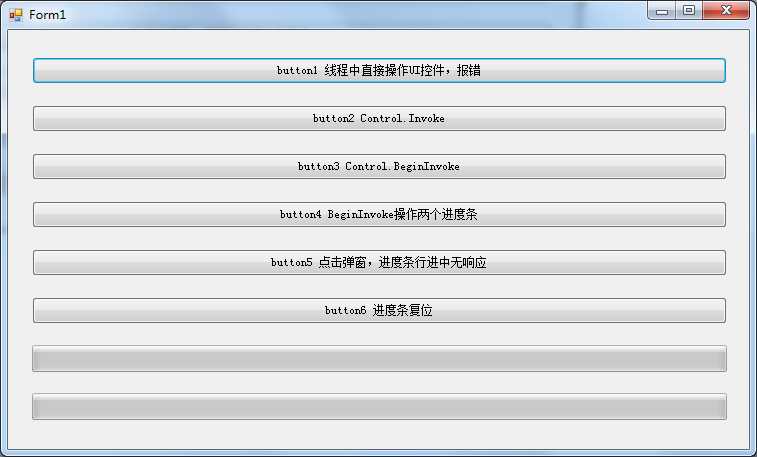System.Windows.Forms.Control.Invoke与BeginInvoke
2021-07-12 21:06
标签:bsp 线程 ESS mars zh-cn 消息 close 报错 对象 WinForm的UI对象只能在UI线程中操作,在非UI线程中操作UI对象,会引发不可预知的错误,这时就需要用到Control.Invoke或者Control.BeginInvoke。 用户线程调用Control.BeginInvoke会向UI消息队列发送一个带委托消息,Control.BeginInvoke不会阻塞用户线程,直接返回IAsyncResult对象。 用户线程调用Control.EndInvoke(IAsyncResult),Control.EndInvoke会阻塞用户线程,直到委托执行完成,并返回委托的返回值。没有返回值返回null。 Control.Invoke相当于Control.BeginInvoke和Control.EndInvoke的合体,会阻塞用户线程,直到委托执行完成,并返回委托的返回值。没有返回值返回null。 根据类继承关系,在窗口中可以直接使用BeginInvoke、EndInvoke、Invoke。 System.Object 实验示例: 窗体: 代码: System.Windows.Forms.Control.Invoke与BeginInvoke 标签:bsp 线程 ESS mars zh-cn 消息 close 报错 对象 原文地址:https://www.cnblogs.com/zhuyingchun/p/9592351.html
??System.MarshalByRefObject
????System.ComponentModel.Component
??????System.Windows.Forms.Control
????????System.Windows.Forms.ScrollableControl
??????????System.Windows.Forms.ContainerControl
????????????System.Windows.Forms.Form


public partial class Form1 : Form
{
public Form1()
{
InitializeComponent();
}
private void button1_Click(object sender, EventArgs e)
{
// 在非UI线程中操作UI对象,调试运行会报错。
// 直接运行会使程序置于不可预知风险之中。
new Thread(() =>
{
progressBar1.Value = 100;
}).Start();
}
private void button2_Click(object sender, EventArgs e)
{
new Thread(() => {
var result = this.Invoke(new Funcint, int, string>((n1, n2) =>
{
for(int i = 0; i 100; i += 10)
{
progressBar1.Value = i;
Thread.Sleep(200);
}
return (n1+n2).ToString();
}), 100, 21);
MessageBox.Show(result.GetType().ToString() + ":" + result);
}).Start();
}
private void button3_Click(object sender, EventArgs e)
{
new Thread(() =>
{
IAsyncResult asyncResult = this.BeginInvoke(new Funcint, int, string>((n1, n2) =>
{
for (int i = 0; i 100; i += 10)
{
progressBar1.Value = i;
Thread.Sleep(200);
}
return (n1 + n2).ToString();
}), 200, 32);
MessageBox.Show("BeginInvoke不会阻塞");
var result = this.EndInvoke(asyncResult);
MessageBox.Show("EndInvoke会阻塞," + result.GetType().ToString() + ":" + result);
}).Start();
}
private void button4_Click(object sender, EventArgs e)
{
// 连续给两个委托,由于UI线程只有一个,两个委托只能先后执行
new Thread(() =>
{
IAsyncResult asyncResult1 = this.BeginInvoke(new Funcint, int, string>((n1, n2) =>
{
for (int i = 0; i 100; i += 10)
{
progressBar1.Value = i;
Thread.Sleep(200);
}
return (n1 + n2).ToString();
}), 200, 32);
IAsyncResult asyncResult2 = this.BeginInvoke(new Funcint, int, string>((n1, n2) =>
{
for (int i = 0; i 100; i += 10)
{
progressBar2.Value = i;
Thread.Sleep(200);
}
return (n1 + n2).ToString();
}), 400, 64);
MessageBox.Show("BeginInvoke不会阻塞");
var result1 = this.EndInvoke(asyncResult1);
MessageBox.Show("EndInvoke(asyncResult1)返回");
var result2 = this.EndInvoke(asyncResult2);
MessageBox.Show("EndInvoke(asyncResult2)返回");
MessageBox.Show(
result1.GetType().ToString() + ":" + result1 + "\r\n" +
result2.GetType().ToString() + ":" + result2);
}).Start();
}
private void button5_Click(object sender, EventArgs e)
{
// 要等精度条更新完成后,点击才能响应
MessageBox.Show("ha");
}
private void button6_Click(object sender, EventArgs e)
{
progressBar1.Value = 0;
progressBar2.Value = 0;
}
}
文章标题:System.Windows.Forms.Control.Invoke与BeginInvoke
文章链接:http://soscw.com/index.php/essay/104328.html